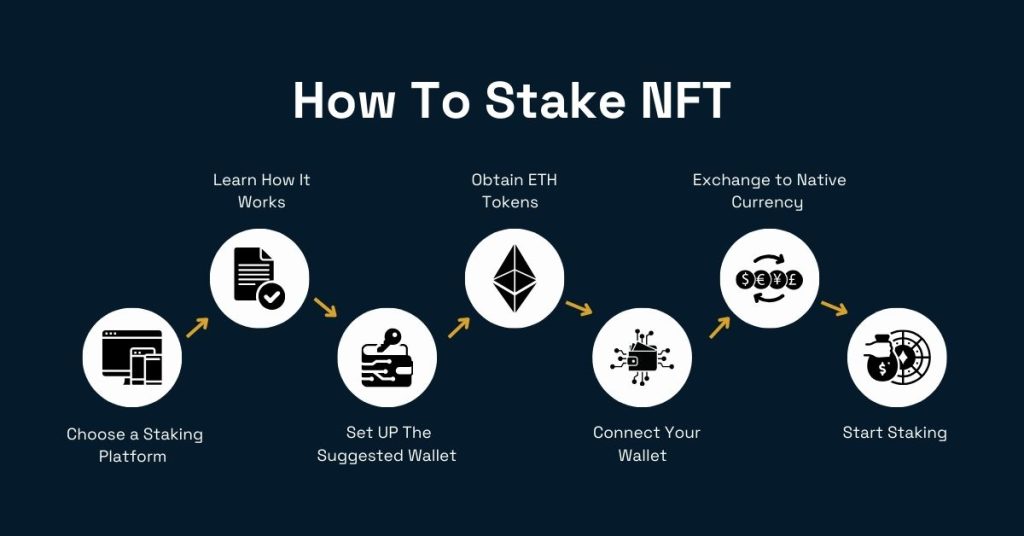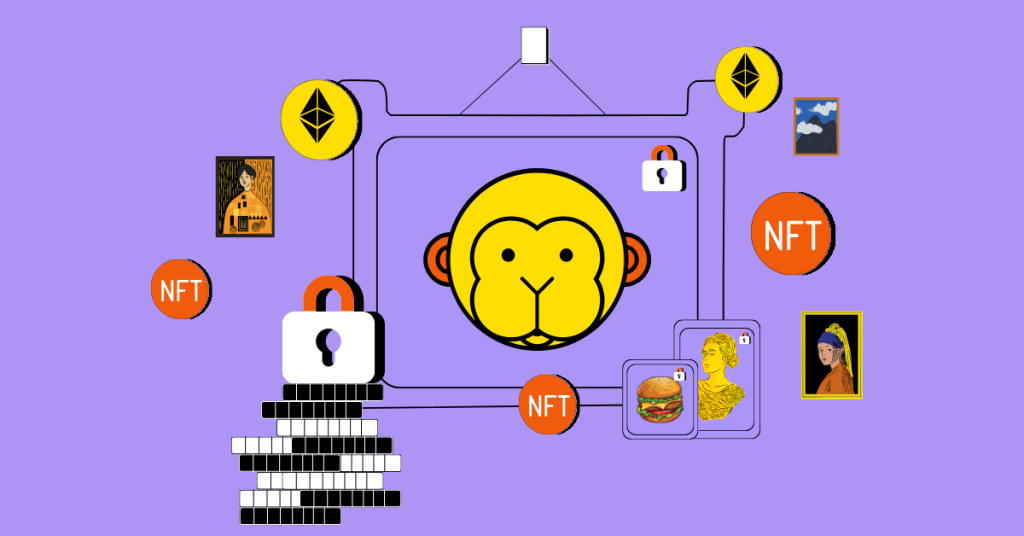The post Getting Into NFT Staking: A Quick Guide for Beginners appeared first on Coinpedia Fintech News
NFT investors primarily aim to generate a reasonable profit. Traditionally, they employ two strategies: minting NFTs and buying low to hold.
Minting NFTs involves creating them during their initial release, with the expectation that the value of these newly minted NFTs will increase over time, allowing investors to sell them later at a higher price. On the other hand, the ‘buy low and hold’ strategy entails purchasing NFTs at relatively low prices and holding onto them, anticipating that their value will appreciate over time, potentially resulting in a profitable sale.
Both of these methods carry risks. If NFT collections fail to increase in value, investors’ funds can remain tied up in these assets. This is where a new strategy becomes relevant: staking NFTs for yield. By employing this strategy, investors can earn rewards without needing to sell their NFT assets. These rewards usually come in the form of additional NFTs or other cryptocurrencies.
Lately, the new strategy has been gaining popularity among NFT investors.
Highlights
Staking NFT means locking them on a compatible blockchain for potential rewards.Staking NFTs involves an eight-step process.NFT staking rewards come from locking your NFTs and receiving regular rewards.Many projects use APY to show potential earnings for NFT staking.NFTX is a well-known NFT staking platform.Earning with NFT staking depends on your goals and risk tolerance.
1. NFT Token Staking Explained
In short, NFT staking is a process in which you immobilise your NFTs by placing them within a specialised contract on a Decentralised Finance platform, temporarily preventing them from being freely traded or used. To understand this process, one should put effort into learning the prime concepts surrounding it deeply.
1.1. What are NFTs in Simple Terms
An NFT, or Non-Fungible Token, is a digital certificate on a blockchain that proves ownership and uniqueness of items like digital art or collectibles in the digital world.
1.2. What’s Staking in Blockchain
This is a process where digital token holders lock up a certain amount of their tokens in a dedicated digital wallet, or staking wallet, to actively support and secure a blockchain network’s operations and functionalities.
1.3. What Does Staking NFTs Mean
In a similar vein, staking NFTs involves staking Non-Fungible Tokens on a compatible blockchain network. Instead of traditional cryptocurrencies, NFT holders lock their NFTs into a smart contract on a compatible blockchain protocol. Once these NFTs are stored within the smart contract’s pool, the NFT depositors may receive rewards. These rewards are typically in the form of additional tokens or cryptocurrency.
1.4. Difference Between Crypto Staking and NFT Staking
Though it appears like crypto staking and NFT staking are the same in nature, there are some serious differences.
Crypto staking involves locking up standard cryptocurrencies like Bitcoin in a digital wallet to secure a blockchain network, validate transactions and earn rewards in the same crypto. On the other hand, NFT staking entails locking NFTs in a smart contract on a blockchain. It does not secure the network like crypto staking but may offer rewards in the form of additional tokens or benefits like voting rights.
 Do You Know
Do You Know
A report published in Finder reveals that in Thailand, 30% of women own NFTs, surpassing the 23% ownership among men. Similarly, in Venezuela, 11% of women own NFTs, compared to 10% of men. These statistics challenges stereotypes and highlight the increasing diversity of NFT enthusiasts, emphasising the NFTs are gaining popular across genders.
2. How To Stake NFT: Step-by-Step

Staking NFTs is a simple, eight-step process.
- Step 1: Choose a Staking Platform
Start by selecting a staking platform that aligns with your preference. It’s good to choose a user-friendly platform.
- Step 2: Learn How It Works
Take adequate time to understand how the chosen platform operates. It is advised to put effort into learning its rules, rewards and processes.
- Step 3: Set UP The Suggested Wallet
If you don’t already have the digital wallet recommended by the chosen platform, install the wallet. MetaMask is the popular choice for NFT staking as it is widely supported in the Ethereum ecosystem, a common blockchain for NFTs and NFT staking.
- Step 4: Obtain ETH Tokens
You will usually need some ETH tokens, unless the platform is on a different blockchain like Cardano or Solana. You can acquire ETH, either by purchasing it or transferring from another wallet.
- Step 5: Connect Your Wallet
Link your wallet to the staking platform.
- Step 6: Exchange to Native Currency
If the platform has its own native currency, you might need to exchange your ETH for it. You should follow the instructions given in the platform related to the same.
- Step 7: Start Staking
You can begin the staking process, once you have the required tokens and your wallet is connected. The process involves locking your NFTs in a smart contract on the platform.
- Step 8: Monitor Rewards
Keep an eye on your staking NFTs and the rewards you earn. Generally, rewards come in the form of additional tokens.
2.1. How Does NFT Staking Rewards Work
Rewards are something that encourages an NFT holder to take part in the staking process. In simple terms, NFT staking rewards work by locking up your NFTs on a staking platform, and in return, you receive regular rewards, weekly or monthly. What you earn as a reward is usually a utility token. You can trade these utility tokens on cryptocurrency exchanges for other cryptocurrencies like Ethereum or Bitcoin, or even turn them into real-world money.
Some platforms go a step further. They might offer DAO, where you can participate in the platform’s decision making by locking your NFTs in a special pool.
Likewise, some projects might reward you with new NFTs or give you access to special sales with discounts. So, not only do you earn tokens, but you might also get more valuable digital items.
2.1.1. Calculating NFT Rewards: What’s the Method
The way NFT rewards are calculated can differ from one project to another. Many NFT projects use Annual Percentage Yield to show you how much you can earn by staking your NFTs. APY, like what the title indicates, is a percentage that represents the annual rate of return. For example, if the APY is 10%, it implies you can expect to earn 10% of your staked NFTs value in rewards over a year.
Importantly, the longer you lock your NFTs in, the more rewards you typically get. This is an incentive to keep your NFTs staked for as long as possible. So, if you stake for a year, you might get a higher percentage of rewards, compared to staking for just a month.
Notably, some projects don’t show your rewards as an APY but instead tell you how many tokens you will receive. For example, if they say you will get 20 tokens per day for staking your NFTs, it means you will earn 20 of their native tokens every day you keep your NFT locked up.
Interesting! What?
In a Business Insider article, Canadian pop artist Grimes, the ex-partner of Elon Musk, revealed that her earnings from selling NFTs have exceeded what she has made in her music career. Grimes and her brother, Mac Boucher, launched the “WarNymph” NFT collection in 2021, generating an astonishing $5.8 million in under 20 minutes. This highlights the remarkable potential of NFTs in reshaping income streams of artists.
3. Points to Remember While Staking NFT
When staking NFTs, here are the key points to keep in mind:
- Eligibility: Check if your NFT can be staked before getting started.
- APY: Understand the Annual Percentage Yield, or APY, to estimate your expected yearly returns.
- Lock-up Period: Know that staking often involves locking up your NFT for a specific period. Choose a time frame that suits you.
- Crypto Volatility: Remember that NFTs and rewards are tied to cryptocurrencies, so their value can change due to crypto market fluctuations.
- Extra Benefits: Some platforms offer more than just rewards, like governance rights. Explore these additional perks.
4. Top NFT Staking Platforms in 2023
There are numerous platforms where you can stake your NFTs and earn impressive rewards and other benefits. Each has its own advantages and disadvantages. It’s difficult to tell which one is the best NFT staking platform. The best method to choose the best platform is to choose the one that suits your requirement.
The below given are some popular NFT staking platforms.
4.1. NFTX
When you stake your NFTs into an NFTX vault, you receive vTokens, which can be used to earn rewards by staking or to buy special NFTs from the vault. You can team up with other vToken holders in Automated Market Makers to create a market for trading, and when you do, you earn fees for providing liquidity.
4.2. Axie Infinity
It introduced its Land Staking Program in July 2022. The program has five types of special NFT lands: Savannah, Forest, Arctic, Mystic, and Genesis. When players stake these Axie land NFTs, they can earn AXS tokens. The amount of AXS tokens of AXS tokens you earn depends on how rare your land NFT is.
4.3. The SandBox
It is a virtual world where players can stake their land NFTS, and receive rewards in return in the form of SAND tokens – the native cryptocurrency of The Sandbox. Interestingly, over $10 million worth of SAND tokens has been allocated by the project to distribute to the land stakers. In simple words, what this provides is an opportunity for those who own land in The Sandbox to earn rewards while the project keeps growing and adding more useful features.
4.4. Only 1
It is the first social NFT platform, built on Solana. It is actually a decentralised version of OnlyFans. Creators on this platform can make special content like posts, images or videos, This content is turned into a NFT. Fans can bid on these NFTs to become the exclusive owners. Other fans can access this exclusive content by using $LIKE, which is the platform’s native token. When they do, both the NFT owners and the original creator get paid in $Like tokens. Notably, you can take your $LIKE tokens and put them to work by staking them on the platform.
5. Is NFT Staking Good Way To Make Money
Whether staking NFTs is a good way to make money depends on your goals and risk tolerance. It does offer rewards, but comes with potential risks. If you plan to hold onto your NFTs for a long time, NFT staking can be a good choice to consider. However, it is essential to be aware of certain security risks, such as hacks. Additionally, it is important to keep in mind that staking NFTs often involve locking up your NFTs, which can reduce their immediate market liquidity.
6. Endnote
NFT staking represents a promising frontier in the world of blockchain technology and digital assets. By allowing NFT holders to participate in network validation and governance while earning rewards, staking adds a valuable layer of utility to non-fungible tokens. This simple yet powerful concept empowers users to actively engage with the blockchain ecosystem, thereby contributing to its security and growth, all while potentially enjoying financial benefits. As the blockchain space continues to evolve, NFT staking is likely to see further development and refinement, offering new opportunities and challenges for participants.
7. FAQs
NFT staking is a process where NFT holders lock up their NFTs in a smart contract to support a blockchain network and earn rewards in return.
NFT staking works by depositing your NFT into a staking platform’s smart contract. This NFT then becomes part of the network’s consensus mechanism, contributing to security and governance decisions, and you earn rewards for your participation.
The best NFT staking platform can vary depending on factors like the blockchain you are interested in and your specific NFT assets. It is essential to research and compare different platforms based on your needs and preferences to determine the most suitable option.
Risks in NFT staking include the potential loss of staked NFTs due to smart contract vulnerabilities, market volatility affecting token values, and the possibility of network changes impacting rewards. It’s essential to assess these risks before participating.
The ability to unstake and any associated penalties vary depending on the specific NFT staking platform and blockchain network. Some platforms offer flexible unstaking options, while others may have lock-up periods or penalties for early withdrawal. It’s crucial to check the platform’s terms and conditions.


